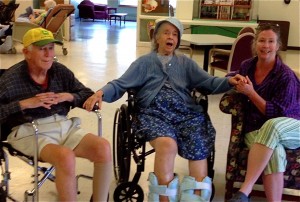by Beth Whitman
For three weeks I had not been out of the house except for very short periods to shop or take care of other necessities. I had canceled or backed out of all my obligations.
Mom was failing. She couldn’t stand up any more. This is Alzheimer’s, and the part of her brain that was going now was the part that tells the body how to stand.
A friend came over to visit, and while we talked, I kept one eye on the monitor. Mom was sitting on the side of the bed and would move her upper body forward to try to push up and off the bed. She would lift herself almost into standing position. Almost, almost . . . and then, kerplunk, she’d sit right back down. Over and over and over again.
“My God,” my friend said, after observing her for a while. “It’s exhausting just watching her.”
Exhausting and heartbreaking. We were all beginning to feel just a little bit desperate. It was a relief when we heard that Glenridge, the Alzhiemer’s care facility near us, had an opening.
But I had one last moment of doubt. Was it really time? I spoke with Dad. Yes, he agreed. It was time.
So the day had come. A friend of ours who has a wheelchair-accessible van picked us up and drove us over to the Glenridge facility 10 miles away. Dad rode in another car with a friend, while Amy and I rode with Mom in the van.
Mom was delighted. She peered excitedly out of the window and read aloud (or at least tried to) every road sign that we passed along the way, as had been her habit for the past 10 years.
Getting Mom in and out of the van on the wheelchair lift was a bit of a challenge, but we figured it out, and we made sure that Mom was facing the inside of the van, rather than the unknown world outside. I stood right in front of her on the lift, held her hand, and got her giggling and laughing as I rubbed noses with her.
The staff came out to welcome us, and we all went into her room. Mom continued to be delighted, saying hello and waving to everyone we passed. Once in her room, she sat happily and talked to all the staff that came and went. Oddly enough, she was more cogent and self-possessed than she had been in a long time!
We had a meal with her there in the room, and then . . .
It was finally time to go. To leave Mom there.
We all kissed her and said goodbye. She waved goodbye to us, and it seemed as though nothing were amiss, nothing was out of the ordinary.
I had this uncontrollable urge to stay and watch and make sure she was okay, make sure she was happy. For both our sakes. But I knew I couldn’t do that. It was neither permitted nor a good idea, considering the whole point of the trip.
The staff assured me that everything would be okay, but what about when she started getting upset? Or overstimulated? What would happen then? Who would kiss her and comb her hair and sit on her lap? Would she be lonely, would she have enough physical contact? Would she get angry because people were patronizing her?
As it turns out, Mom blossomed again once she got into the routine of the facility. She was given a reclining wheelchair and she now spends her days pulling herself along the hallways, exploring every nook and cranny of the place.
Often when I walk in, a staff person will see me and say, “I just saw your mom down in the activities room, but she was on the move, and heading towards the blue wing!” When I find her, I take her hand and we spend an hour or so exploring the halls together.
At first, Dad and I went to Glenridge every day. Mom was soooo happy to see us. Although she was more comfortable there, and happier overall, she was not so excited about being around the other residents in the facility. She couldn’t fully verbalize it, but she would chatter excitedly to Dad and me. And a few of the words, and their meaning, could be easily discerned:
“So nice . . . so nice.”
“You . . . here . . . So nice.”
“Not like these . . . ” She motioned her hand around the room. “These . . . these . . . .” She made a face, sticking her tongue out sideways and rolling her eyes toward the ceiling.
And then she leaned back towards us, grabbing our hands and kissing them, diving right back into the happy chatter.
Beth Whitman lives in Maine and is a member of Belfast Cohousing and Ecovillage, a developing community on the coast of Maine focused on multigenerational living and sustainability.







Beth,
Thank you for sharing this very touching, personal story of your Mom’s and your journey. I wish you God’s blessing.
Dear Beth,
I remember those days with my Mom. My feelings were the same. Today 3 years ago I lost my Momma to this horrible disease. Just know that you are doing the right thing. I will be with you through your journey and will send you strength and blessings!